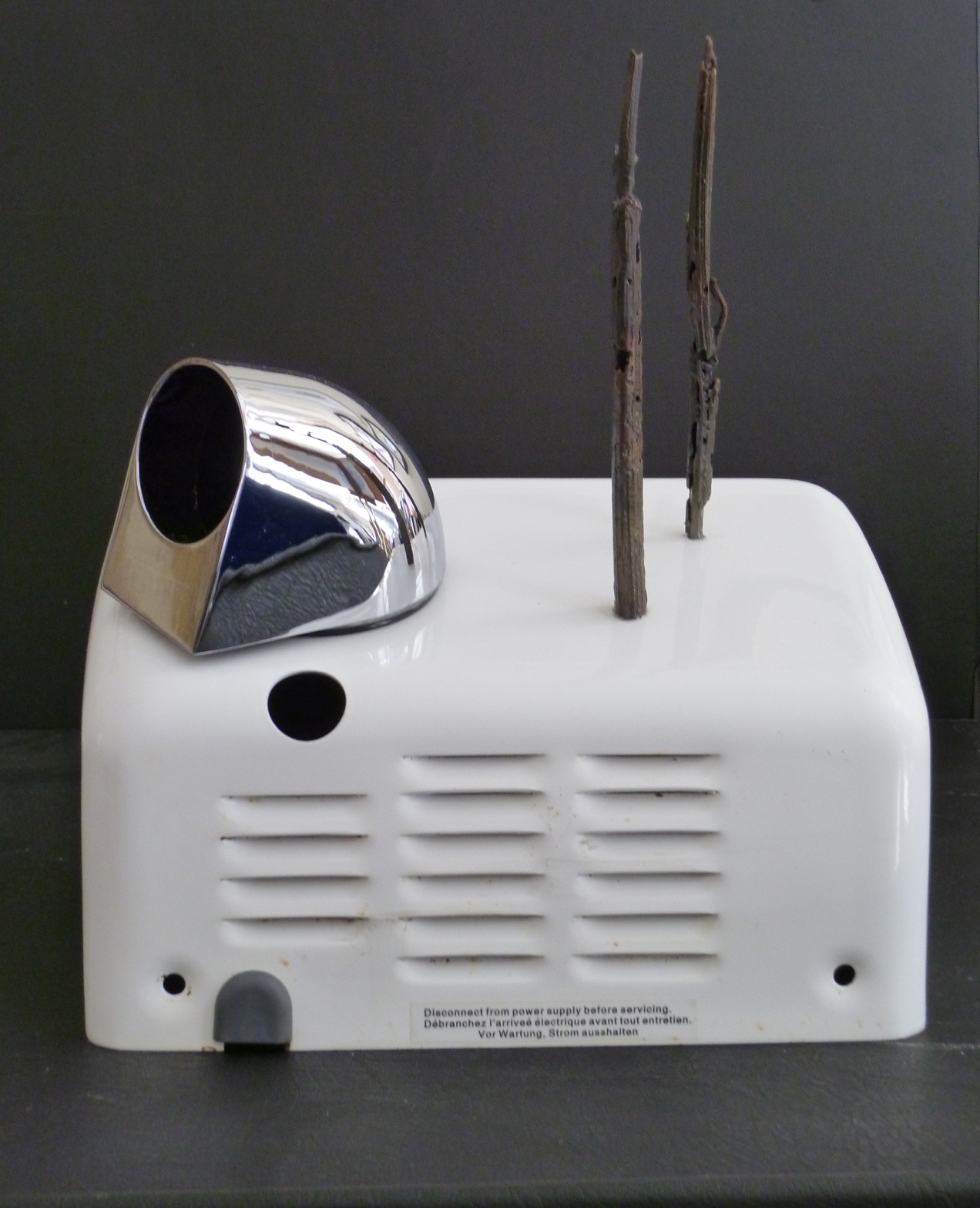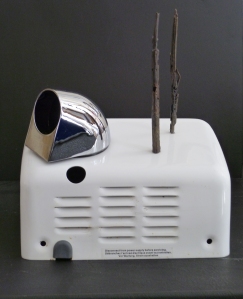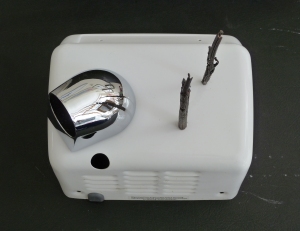This new piece of sculpture has been made from a found object (a hand dryer) and the stems of an artichoke cast in bronze. Thus it is an assemblage of found and made objects. It is untitled and designed to be displayed as shown here, on a black base with a three black low-sided flats.
It is one in a number of works that record my interest in reflective surfaces and bathroom furniture and stems from a number of sources. I will begin with the reflective materials interest first. I remember reading that people become less violent and aggressive if they see themselves reflected. The research was looking into how hostility could be reduced in users of public services and concluded that people would behave better if they could see themselves. I don’t remember where I saw this; it was some years ago and possibly when I was working in a customer-facing role, shortly after a violent customer held me hostage. I don’t know whether this research has been followed up or acted upon either as I see little evidence of it in places I’ve visited. Anyway, I wonder whether people would have acted differently had they seen themselves reflected as a whole and whether violent nations or groups could similarly have a large or virtual mirror held up for them to see themselves. I made a piece on Nazism using this thought a few years ago and have been drawn to reflective surfaces from time to time, like the two pieces I have made recently; one with a pedestal; and the one illustrated here with a hand dryer.
I am not just content to exhibit the found object but want to use it in combination with something else. Here, I have used bronze stalks from artichokes that are rising vertically from one of the surfaces of the dryer. The dryer is displayed on its back; it is not mounted, as it would be in a bathroom. It is washed up and lying prostrate so that all of its outer surfaces can be seen, only its innards are not visible and the workings which drive the dryer have been removed so it is without the ability to perform its intended function. In this respect, it is just a casing, a husk, a shell, the housing for an object that can no longer work as intended; it is breathless and mute, its chrome proboscis looking silently outward.
As a dryer, it also had a public or corporate function. Dryers are not installed in homes, but public lavatories or business ones, so it gestures to a life outside of the home and one which served two types of users, an internal one, or a passing one. I know nothing about the origin of it before I found it in a skip, and can only speculate on its provenance or past life. The viewer must make their own mind up. Suffice to say, it is now joined with two vertical damaged uprights with filigree lesions that hint at decay, disease, absence. For me these have some sense of the exterior of the Twin Towers, which I saw fall in front of me. I did not intend to echo that, there was no deliberate design, just happenstance. There are echoes too of an object given to bluster and things reduced, cut down.
The uprights are reflected in the nozzle as is the surrounding and possibly, the viewer too. All caught up in an elliptical world and offered back for inspection and reflection. The piece has no didactic intention, it is presented without a title and with little guide as to what the viewer should take from it, rather it is intended that the viewer take what they invest. In the looking and consideration.
My other interest in bathrooms is more personal and darker still, if that can be possible. It refers to one of my relatives who was victim of a mass murder and was tied up and burned to death in a bathroom, his wooden leg (after a war injury) providing further grist to the flames. The bathroom becoming a place of horror rather than a place of cleansing is a difficult one. The fact too, that a bathroom would have had mirrors that failed to limit the anger or actions of the perpetrators is an ironic twist on the aforementioned violence lessening possibilities of mirrors, one that is not lost on me as I reflect on the piece.
But the artwork is in two parts, one offering support to the other, or anchoring it and reflecting it to a world that encompasses the viewer. It offers some key as to why I think it works as an artwork. Does it fulfil a role in the attempt to make a forgettable artwork too? I think that the previous roles of the two elements are implied and forgotten by the combination. The voice and function of the dryer is lost or forgotten, although by forcible removal. Sadly, the piece is memorable in its abjectness and therefore fails as a forgettable work.
For me personally it offers many recollections. But, in the act of making and assemblage, it goes beyond these histories and transcends them. Thus it may render them forgotten or erased, providing an object for contemplation in its own right. Maybe, that is where the forgetting happens – in the slippage between the possible pasts and possible more positive futures.


